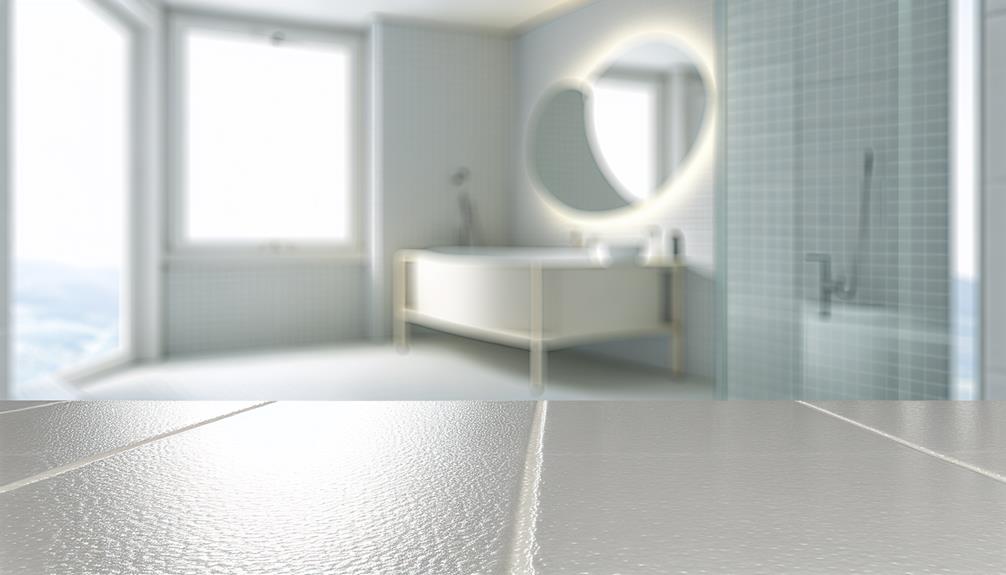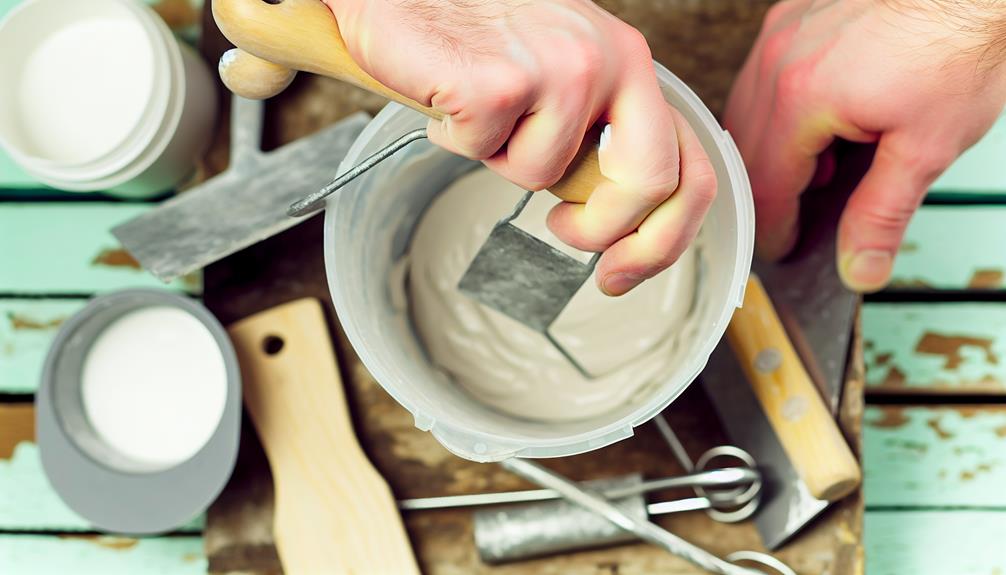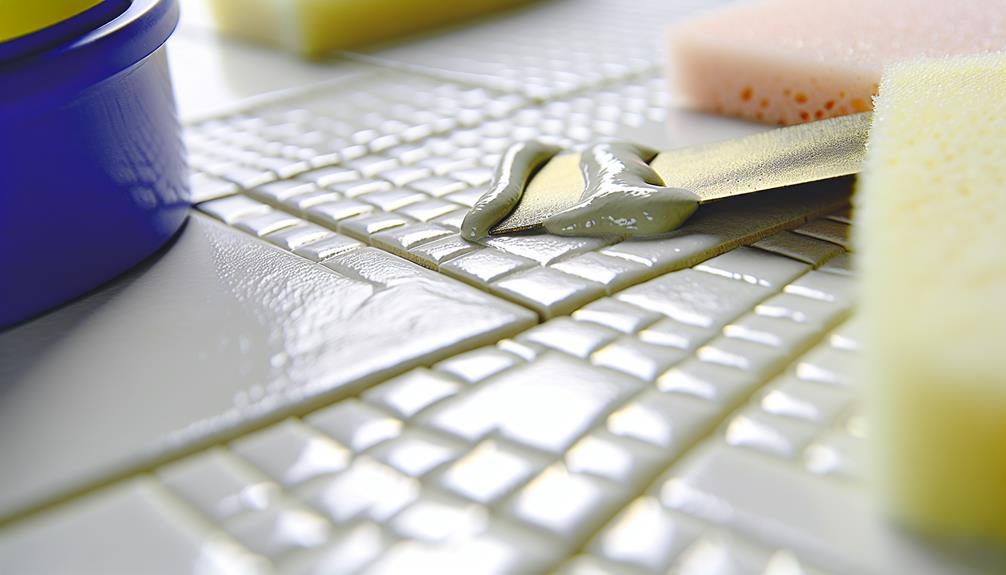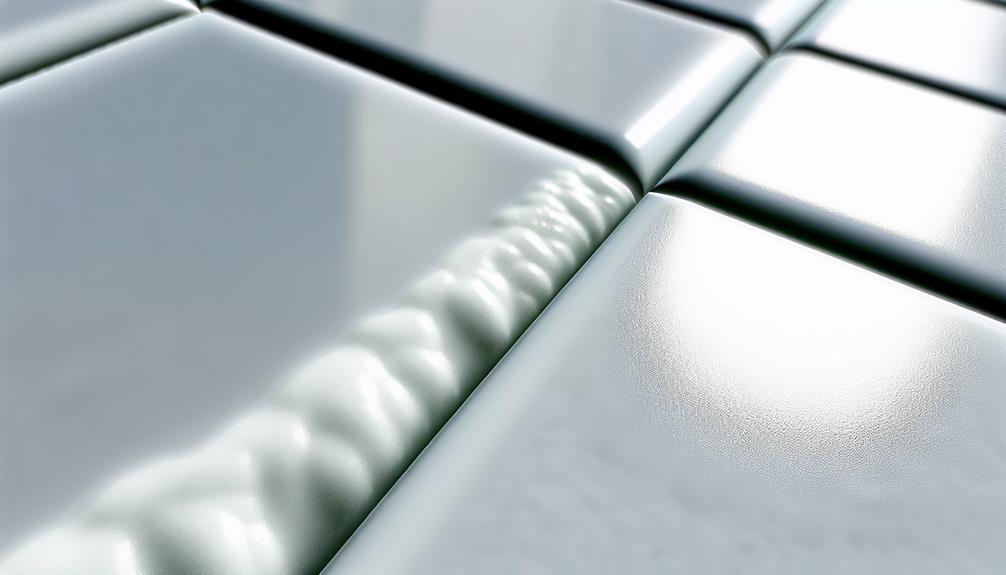To achieve the perfect finish with Frost Grout, begin with thorough surface preparation, ensuring cleanliness and priming for ideal adhesion. Mix the grout correctly, adhering to a 25%-30% water ratio using room temperature water, and blend until a thick pancake batter consistency is achieved. Apply the grout using a float at a 45-degree angle, employing circular motions for even distribution. Post-application, utilize a damp sponge to remove excess grout promptly. Pay attention to color selection and texture, as they greatly affect the final appearance. With the right techniques and materials, a flawless finish is within reach, offering further insights into maintaining your work effectively.
Key Takeaways
- Ensure thorough surface cleaning and priming to enhance grout adhesion and prevent cracking.
- Mix Frost Grout with 25%-30% water, achieving a thick pancake batter consistency for optimal application.
- Use a grout float at a 45-degree angle for even spreading and firmly pressing grout into tile joints.
- Apply desired textures using sponges or brushes to create unique surface finishes aligned with your design intent.
- Regularly maintain grout with mild cleaners and sealers to preserve its appearance and durability over time.
Understanding Frost Grout

Understanding Frost Grout is vital for achieving ideal results in various tiling applications. This specialized grout is engineered to withstand extreme temperature fluctuations, making it an ideal choice for both indoor and outdoor settings. Its impressive durability is comparable to that of low-maintenance lawns, like those created with Zoysia sod. The benefits of frost grout extend beyond mere durability; it offers enhanced resistance to moisture and staining, guaranteeing longevity and maintaining aesthetic appeal.
Frost grout is available in a variety of colors, allowing for a seamless integration with diverse tile designs. This versatility not only enhances the visual impact of a tiled surface but also enables professionals to create cohesive and attractive installations. Selecting the appropriate frost grout color can greatly influence the overall ambiance, making it essential for designers and contractors to take this aspect into account during project planning.
In addition, the application of frost grout contributes to the structural integrity of tiled surfaces, preventing cracks and deterioration over time. Its unique formulation provides ideal adhesion and flexibility, accommodating the natural expansion and contraction of materials. By understanding the properties and advantages of frost grout, professionals can guarantee their projects meet the highest standards of quality and aesthetic appeal.
Preparing Your Surface
Achieving a flawless finish with frost grout begins with meticulous surface preparation. Proper preparation is essential to guarantee that the grout adheres effectively and performs at its best over time. Start with thorough surface cleaning to remove any dust, debris, or contaminants that may hinder adhesion. Utilizing a suitable cleaning solution tailored for the specific substrate, whether it be tile, stone, or concrete, is vital for achieving superior results, just as one would consider factors like cost-effectiveness when choosing appliances for efficient home use. Pay special attention to corners and grout lines, as these areas can accumulate residues that disrupt the finished appearance.
Following surface cleaning, the next important step is surface priming. Priming enhances the bond between the substrate and the grout, reducing the risk of future cracking or peeling. Choose a high-quality primer designed for the material you are working with, applying it evenly across the surface. Allow sufficient drying time as per the manufacturer's guidelines before proceeding with the application of frost grout.
Mixing Frost Grout Properly

To achieve ideal results with frost grout, it is vital to utilize the correct mixing tools, such as a mechanical mixer and appropriate containers. Confirming that you have a solid foundation in mixing techniques can greatly impact your project outcome, much like how Pilates workouts enhance overall wellness. Additionally, maintaining the proper water-to-grout ratio is essential to guarantee consistency and workability. Adhering to these guidelines will facilitate a smooth application and enhance the overall finish.
Essential Mixing Tools
What tools are vital for effectively mixing frost grout? The selection of appropriate mixing tools is fundamental for achieving ideal results. Begin with a high-quality mixing paddle, specifically designed for heavy materials. This paddle should create a vortex that thoroughly blends the components without introducing excess air, which can compromise the grout's integrity.
A robust electric drill with adjustable speed settings is indispensable. This allows for precise control over mixing techniques, ensuring consistent texture and eliminating lumps. Depending on the project scale, a bucket or mixing tub made of durable material is necessary to withstand heavy use while providing ample space for thorough mixing.
For smaller projects, consider utilizing a hand mixer, which can be effective for achieving a well-blended mixture on a limited scale. Additionally, a trowel or margin trowel can facilitate the transfer of grout to the application area, ensuring an efficient workflow.
Ultimately, careful tool selection not only enhances the mixing process but also contributes to the overall quality of the finished product. Invest in these vital tools to foster a sense of belonging within the community of skilled craftsmen dedicated to achieving the perfect finish with frost grout.
Proper Water Ratio
The effectiveness of mixing frost grout hinges greatly on the proper water ratio, as this parameter directly influences the consistency, workability, and durability of the final product. Achieving the ideal water-to-grout ratio is paramount; typically, a range of 25% to 30% water by weight of the dry grout is recommended. This facilitates optimal hydration while preventing excessive fluidity, which can compromise structural integrity.
Another critical factor is water temperature. Ideally, the water used should be at room temperature, around 20°C (68°F). Using cold water may extend the mixing time and delay the curing process, while hot water could accelerate hydration too rapidly, leading to cracking. A consistent mixing time of 3 to 5 minutes is essential to guarantee uniform distribution of water throughout the grout, allowing for complete hydration of the cement particles.
It is advisable to gradually add water and mix thoroughly to attain the desired consistency, which should resemble that of thick pancake batter. Achieving this balance not only enhances workability but also considerably contributes to the performance and longevity of the frost grout application.
Application Techniques
Achieving a flawless application of frost grout requires meticulous attention to detail and adherence to specific techniques. The process begins with careful color selection, ensuring that the grout complements the tiles and overall design aesthetic. Once the appropriate color is chosen, it is essential to prepare the work area adequately, ensuring that surfaces are clean and free from debris. Utilizing proper tools and storage options can enhance your efficiency during this process, so consider choosing the perfect metal toolbox to keep your grout application tools organized.
Applying frost grout involves employing effective smoothing techniques to achieve a uniform finish. Begin by using a grout float to spread the mixture evenly into the joints, ensuring full coverage. Hold the float at a 45-degree angle to prevent excess grout from being pushed into the joints.
As you work, use a circular motion to press the grout firmly into the spaces between tiles. After initial application, let the grout set for a few minutes before using a damp sponge to gently wipe away any excess from the tile surface. This step not only enhances the appearance but also prevents future staining.
Finishing Touches

When it comes to applying the finishing touches to frost grout, attention to detail is vital for guaranteeing a seamless and polished appearance. The final presentation of your grout work can greatly enhance the overall aesthetic of your installation. Begin by evaluating the selected color options; frost grout offers a variety of hues that can complement or contrast with tile surfaces. Choosing the right color is essential, as it can influence the perceived size and texture of the spaces. Consider how the color choices can impact the overall beauty and durability of your project, much like selecting quality materials for a long-lasting finish.
Next, consider the texture effects you wish to achieve. Frost grout can be manipulated to create varying surface finishes, from smooth to more pronounced, depending on your design intent. Tools such as sponges, brushes, or specialized applicators can be employed to achieve these effects effectively.
Additionally, make certain that any excess grout is carefully removed and that the joints are even and uniform. This meticulous approach not only enhances durability but also contributes to a professional finish. By focusing on these finishing touches, you can elevate your project, guaranteeing that the grout installation is not just functional but also a visually appealing element of your space.
Maintenance Tips
Regular maintenance of frost grout is essential for preserving its appearance and integrity over time. By implementing effective cleaning techniques and appropriate sealing options, you can guarantee that your grout remains in peak condition. Here are four key maintenance tips to take into account:
- Regular Cleaning: Utilize a mild, pH-balanced cleaner to remove dirt and stains. Avoid harsh chemicals that can damage the grout's finish.
- Seal the Grout: Apply a high-quality sealer every 6 to 12 months. This protective layer enhances resistance to moisture and staining, greatly prolonging the grout's lifespan.
- Prompt Stain Removal: Address spills immediately by blotting with a soft cloth. For stubborn stains, use a specialized grout cleaner, guaranteeing that it is compatible with frost grout.
- Inspect and Repair: Regularly check for cracks or damage. Promptly repair any issues to prevent further deterioration and maintain the grout's structural integrity.
Frequently Asked Questions
Can I Use Frost Grout Outdoors in Freezing Temperatures?
Frost grout is specifically designed for outdoor applications and can withstand freezing conditions. However, it is vital to guarantee that the substrate is adequately prepared and that the grout is applied according to the manufacturer's guidelines. For peak performance, avoid using frost grout during extreme cold spells or when temperatures are expected to drop considerably shortly after application. Proper timing and technique are essential to achieving a durable and aesthetically pleasing finish.
How Long Does Frost Grout Take to Cure Completely?
The cure time for frost grout typically ranges from 24 to 72 hours, depending on temperature effects and environmental conditions. In colder temperatures, the curing process may be prolonged, as lower ambient conditions can hinder moisture evaporation and chemical reactions essential for setting. For best results, it is advisable to maintain temperatures above freezing during installation and curing, ensuring that the grout achieves its full strength and durability as intended.
Is Frost Grout Suitable for All Tile Types?
Frost grout is designed with specific properties that enhance its performance in various environments. However, its compatibility with tile types is contingent upon the materials involved. While frost grout works well with ceramic, porcelain, and natural stone tiles, it may not be suitable for softer or porous materials that could absorb moisture and lead to deterioration. It is crucial to assess tile compatibility to guarantee ideal adhesion and longevity in your installation.
What Tools Do I Need for Applying Frost Grout?
To effectively perform grout application, it is vital to have the right tools on hand. Key items include a mixing bucket for proper mixing techniques, a margin trowel for applying grout into joints, and a rubber float to guarantee an even surface. Additionally, a sponge, grout sealer, and a grout saw may be necessary for finishing touches. Utilizing these tools will facilitate a smooth and professional application process, yielding ideal results.
Can I Tint Frost Grout for a Different Color?
Yes, frost grout can be tinted to achieve various color options. Utilizing effective tinting techniques, such as incorporating powdered pigments or liquid colorants specifically formulated for grout, allows for customization. It is essential to follow manufacturer guidelines to guarantee proper mixing ratios and to maintain the integrity of the grout. This approach not only enhances aesthetic appeal but also guarantees a cohesive design that resonates with your overall project vision.

